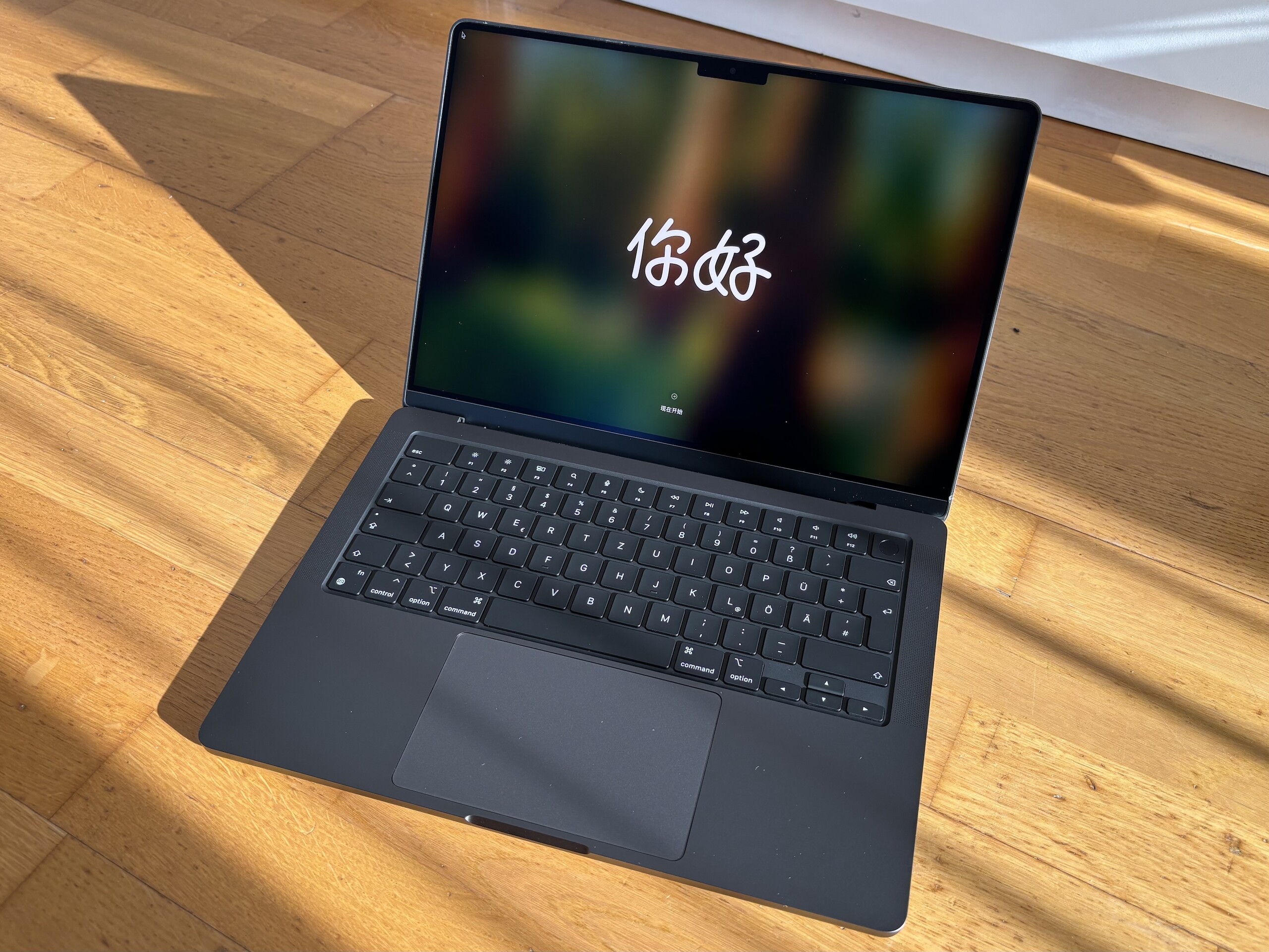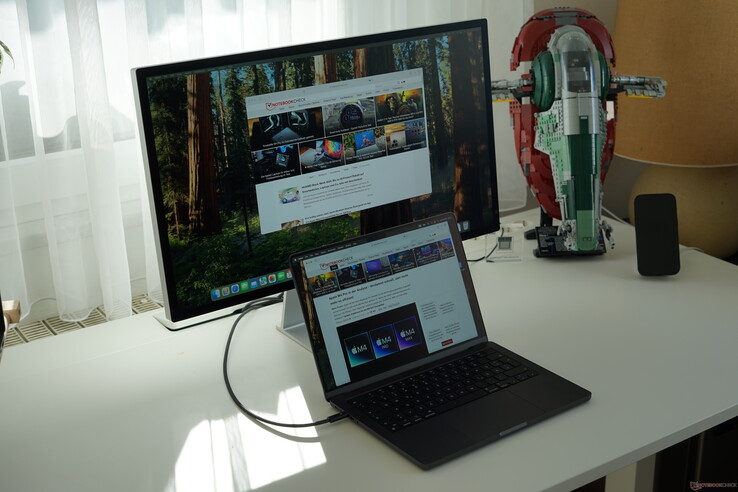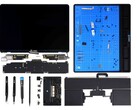
Apple MacBook Pro 14 2024 (M4 Pro, base SKU) laptop review - Who needs the M4 Pro?
More joy with 12 cores?
12 processor cores, 24 GB of RAM, and a 16-core graphics card are supposed to entice the buyer to part with their money. After the base model did an excellent job, we still need to find out what extra value the small M4 Pro brings to the table.Klaus Hinum (translated by Mark Riege) Published 🇩🇪 🇪🇸 ...
Verdict - Is the M4 enough?
In contrast to the M3 generation, the upgrade to the Pro processor in the M4 generation turns out significantly smaller. Most users should probably get sufficient performance already with the base model MacBook Pro with the M4. In terms of CPU performance, the small M4 Pro with 12 cores places easily between the M4 and M4 Pro with 14 cores. The largest differences can be found in the 3D performance. But since games unfortunately still play a rather minor role with the Mac, this might be less relevant for many users.
Independent of the version, the MacBook Pro 14 continues to be an excellent laptop. Particularly the new nano-texture display is very attractive and also allows using it outdoors with its high brightness. The silent cooling is a definite plus especially in quiet surroundings, but this has been "typical" for Apple again since the Apple M1.
Since we mainly look at the performance in our test update, we recommend also reading the extensive tests of the other M4 MacBook Pros from the series:
Pros
Cons
Price and Availability
The most affordable M4 Pro model is currently (December 2024) available in the Apple Store for $1,999. Our test unit includes two upgrades: the nano-texture display for an additional $150 and 1 TB SSD storage for $200, resulting in a hefty $2,349. At Amazon, the MBP14 with the M4 Pro starts from $1,799.
As unfortunately is customary with Apple, any upgrades to the main storage, SSD, and processor turn out to be very expensive.
Possible Alternatives in Comparison
Image | Model / Review | Price | Weight | Height | Display |
|---|---|---|---|---|---|
| Apple MacBook Pro 14 2024 M4 Pro Entry Apple M4 Pro (12 cores) ⎘ Apple M4 Pro 16-Core GPU ⎘ 24 GB Memory, 1024 GB SSD | Amazon: 1. $2,099.00 Apple 2024 MacBook Pro Lapto... 2. $2,189.00 Apple 2024 MacBook Pro Lapto... 3. $3,059.00 Apple 2024 MacBook Pro Lapto... List Price: 2799 Euro | 1.6 kg | 15.5 mm | 14.20" 3024x1964 254 PPI MiniLED | |
| Apple MacBook Pro 14 2024 M4 Apple M4 (10 cores) ⎘ Apple M4 10-core GPU ⎘ 16 GB Memory, 512 GB SSD | Amazon: $1,699.00 List Price: 1899€ | 1.5 kg | 15.5 mm | 14.20" 3024x1964 254 PPI MiniLED | |
| Apple MacBook Pro 14 2024 M4 Pro Apple M4 Pro (14 cores) ⎘ Apple M4 Pro 20-Core GPU ⎘ 48 GB Memory, 2048 GB SSD | Amazon: $2,318.00 List Price: 3989 Euro | 1.6 kg | 15.5 mm | 14.20" 3024x1964 254 PPI MiniLED | |
| Apple MacBook Pro 14 2023 M3 Pro Apple M3 Pro 11-Core ⎘ Apple M3 Pro 14-Core GPU ⎘ 18 GB Memory, 512 GB SSD | Amazon: List Price: 2499€ | 1.6 kg | 15.5 mm | 14.20" 3024x1964 254 PPI Mini-LED | |
| Apple MacBook Pro 14 2023 M3 Max Apple M3 Max 16-Core ⎘ Apple M3 Max 40-Core GPU ⎘ 64 GB Memory, 2048 GB SSD | Amazon: List Price: 5264€ | 1.6 kg | 15.5 mm | 14.20" 3024x1964 254 PPI Mini-LED |
We purchased our test unit for the editorial team in the Apple store at its release. We decided for the smaller version of the MacBook Pro 14 with the 12-core M4 Pro processor but also splurged for two upgrades to our model: The storage solution was increased from 512 GB to 1 TB and of course we also had to get the new matte display with the nano-texture.
Specifications
Case
There are no differences between the cases of the various M4 versions, and all buyers receive the same aluminum case that has been copied many times.
Equipment
In contrast to the base model with the M4 CPU, you don't have to deal with any compromises in the equipment of the entry M4 Pro. The MacBook also supports Thunderbolt 5 (up to 120 Gbit/s), and the M4 Max models can support more than two external displays.
Display
Some quick measurements of the display show comparable values in our test unit to the M4 Pro 14C models that we tested previously.
| |||||||||||||||||||||||||
Brightness Distribution: 95 %
Center on Battery: 634 cd/m²
Contrast: ∞:1 (Black: 0 cd/m²)
96.6% sRGB (Argyll 3D)
Performance
The entry model of the M4 Pro already includes 24 GB of RAM. Since Apple uses "unified memory," the GPU is able to access all of this storage.
Test Conditions
The MacBook Pro 14 with the current macOS Sequoia 15.1.1 offers three options in the Battery menu of the Settings: Low Power, Automatic, and High Power. In our tests, this didn't have much of an influence on the benchmarks, so we ran most tests in "Automatic" mode.
Processor - Even the slimmed down version of the M4 Pro is convincing
The slimmed down M4 Pro offers a total of 12 of the 14 CPU cores, divided into 8 fast Performance cores and 4 smaller Efficiency cores. The clock speeds are identical to those of the more powerful models including the M4 Max. The Efficiency cores reach clock speeds up to 2.59 GHz and the Performance cores up to 4.51 GHz. Only the M4 offers slightly different clock speeds.
As expected, there are hardly any differences in the single core performance between the M4, M4 Pro, and even the M4 Max. Compared to the M3 generation, there are respectable gains of 18 to 19%, depending on the benchmark. The competitors from Intel, AMD, and Qualcomm are now clearly surpassed. In Cinebench 2024, the X1E-84-100 and i9-14900HX are both 25% slower. While the differences are less pronounced in the older CB R23, a single M4 core still remains slightly ahead of the 14900HX and Ryzen AI 9 HX 370.
Only when all the cores are fully loaded do we see some clear differences between the M4 versions in the MacBook Pro. Due to its lack of P cores, the M4 base version is about 30% slower, and the full version of the M4 Pro is 18% faster. In the comparison with Intel and AMD, the M4 Pro is unable to gain a spot on the winner's podium. A 14900HX with sufficient TDP and cooling is able to clearly move ahead, but it can also be much slower if housed in a slim case. The Ryzen 9 7945HX remains the champion and can only be surpassed by the M4 Max (Cinebench 2024). Ryzen AI 9 HX 370 and also Snapdragon X Elite chips place behind the M4 Pro.
The M4 Pro unable to maintain its performance completely unchanged, even in the "High Power" mode. This is a bit surprising, since the more powerful version in the same case levels out at a significantly higher performance level. In our Cinebench R15 test, the CPU loses about 11% of its performance, with the largest drops after the first two runs.
In battery operation, the full CPU performance remains available up to about 4% of charge, which is an advantage that isn't offered by many Windows competitors.
Cinebench R15 Multi Constant Load Test
Cinebench R23: Multi Core | Single Core
Cinebench R15: CPU Multi 64Bit | CPU Single 64Bit
Geekbench 6.5: Multi-Core | Single-Core
Cinebench 2024: CPU Single Core | CPU Multi Core
Blender: v3.3 Classroom CPU
Cinebench R23: Multi Core | Single Core
Cinebench R15: CPU Multi 64Bit | CPU Single 64Bit
Geekbench 6.5: Multi-Core | Single-Core
Cinebench 2024: CPU Single Core | CPU Multi Core
Blender: v3.3 Classroom CPU
* ... smaller is better
System Performance
The new M4 Pro is also able to flex its muscles in the system performance. But the difference to the M4 base model is as small as expected, since that already reaches the level of the M3 Max MacBook Pro in Crossmark. The 14-core model isn't noticeably faster with a maximum difference of 2%, and the M4 Max is able to achieve an advantage of 6%. The fastest laptop is currently the Schenker XMG Neo 16 with an i9-14900HX and a 10% advantage. The Qualcomm devices such as the Surface Pro OLED remain significantly behind (68% in Crossmark). The fastest AMD based laptop (R9 7945HX3D in the ROG Strix Scar 17) is 2% slower.
WebXPRT 3: Overall
WebXPRT 4: Overall
Mozilla Kraken 1.1: Total
WebXPRT 3: Overall
WebXPRT 4: Overall
Mozilla Kraken 1.1: Total
* ... smaller is better
Storage Solution - Nothing new with the soldered SSD
In addition to the matte display, the 1TB SSD is the second update in our test unit. The performance is comparable to the 2TB version and only imperceptibly slower. In contrast to the new Mac Mini, the SSD in the MacBook Pro cannot be replaced, since it continues to be directly soldered onto the mainboard.
Graphics Card - Clearly cut back but still very fast
The integrated graphics card in the M4 Pro entry model was also cut back by several cores, now only offering 16 of the 20 cores in the chip. The storage bandwidth also plays a more significant role, resulting in much larger differences between the various M4 versions. With its 10-core GPU, the M4 base model only achieves 58% in GFXBench Aztec Ruins High 4k, and the 20-core version is able to move ahead by 22%. The M4 Max, which offers a respectable 40 cores, is able to raise itself into another league by about 225%.
In the comparison with the predecessors, the performance is comparable with that of the 18-core M3 Pro model. In GFXBench, Windows laptops with a faster iGPU such as the AMD Radeon 780M or Intel Arc 8-core are left clearly behind. A dedicated RTX 4060 Laptop GPU (for example in the ThinkPad P1 Gen 7) is more comparable here.
* ... smaller is better
Gaming Performance - MacOS unable to make use of the performance
In the gaming performance, the relatively powerful graphics unit suffers under MacOS and the limited availability of games. As soon as you play some Windows games via CrossOver, you naturally have to accept some clear losses in the performance. Even in native games such as Shadow of the Tomb Raider, it is unable to reach the performance of an RTX 4060. In Baldur's Gate 3, the 4060 is twice as fast in 1080p. Our M4 Pro test unit with the 16-core GPU is only able to keep up with an Nvidia GeForce RTX 4050 in the Dell XPS 14 here.
| Cyberpunk 2077 2.2 Phantom Liberty - 1920x1080 Ultra Preset (FSR off) | |
| Apple MacBook Pro 14 2024 M4 Pro Entry | |
| Apple MacBook Pro 14 2024 M4 Pro Entry | |
| Apple MacBook Pro 14 2023 M3 Max | |
| Apple MacBook Pro 14 2024 M4 Pro | |
| Average of class Multimedia (6.41 - 112.3, n=70, last 2 years) | |
| Apple MacBook Pro 16 2023 M3 Pro | |
| Apple Mac Mini M4 | |
| Apple MacBook Pro 14 2024 M4 | |
| low | med. | high | ultra | QHD | 4K | |
|---|---|---|---|---|---|---|
| Shadow of the Tomb Raider (2018) | 185 | 89 | 86 | 76 | 50 | |
| Total War: Three Kingdoms (2019) | 316.8 | 103.4 | 66.9 | 49.6 | 31.5 | |
| Baldur's Gate 3 (2023) | 50.3 | 36 | ||||
| Cyberpunk 2077 2.2 Phantom Liberty (2023) | 70 | 55.7 | 47.3 | 41.9 | ||
| Total War Pharaoh (2023) | 51.4 | 46.7 | ||||
| Civilization 7 (2025) | 145 | 95.9 | 47.8 |
Emissions
Noise Levels
There is no difference between the M4 Pro entry processor and the more powerful model (see for details) in terms of noise levels. The fans remain mostly turned off, and even under longer load, Apple prioritizes a quiet operation, allowing the components to get warm.
Temperatures - Comfortably warm in winter
The maximum surface temperatures that we measured are comparable to those from our M4 Pro test with a maximum of 48°C (118 °F) on top and 44°C (111 °F) on the bottom.
(+) The palmrests and touchpad are reaching skin temperature as a maximum (33 °C / 91.4 F) and are therefore not hot.
(-) The average temperature of the palmrest area of similar devices was 28.7 °C / 83.7 F (-4.3 °C / -7.7 F).
Stress Test - Hot inside!
With the internal temperatures, things get hot, as is customary with the MacBooks. Apple prefers quiet fans and hot temperatures. With simultaneous CPU and GPU load, the chip reaches temperatures up to 103 °C (217 °F; CPU section).
| CPU Clock E-Cores (GHz) | CPU Clock P-Cores (GHz) | GPU Clock (MHz) | Average CPU Temperature (°C/°F) | Average GPU Temperature (°C/°F) | |
| System Idle | 1181 | 2078 | 338 | 40/104 | 41/106 |
| Valley ultra | 1814 | 3919 | 1557 | 88/190 | 87/189 |
| CB15 + Valley ultra | 2485 | 3450 | 1552 | 103/217 | 87/189 |
Power Management
Power Consumption - Efficient M4 Pro
In the power consumption, the entry M4 Pro places between the M4 and M4 Pro as expected, remaining within similar ranges as the predecessor model. The MacBooks always do very well in the class comparison, and particularly the minimum consumption is outstanding.
| Off / Standby | |
| Idle | |
| Load |
|
Key:
min: | |
| Apple MacBook Pro 14 2024 M4 Pro Entry M4 Pro (12 cores), M4 Pro 16-Core GPU, Apple SSD AP1024Z, MiniLED, 3024x1964, 14.2" | Apple MacBook Pro 14 2024 M4 M4 (10 cores), M4 10-Core GPU, Apple SSD AP0512Z, MiniLED, 3024x1964, 14.2" | Apple MacBook Pro 14 2024 M4 Pro M4 Pro (14 cores), M4 Pro 20-Core GPU, Apple SSD AP2048Z, MiniLED, 3024x1964, 14.2" | Apple MacBook Pro 16 M4 Max M4 Max (16 cores), M4 Max 40-Core GPU, Apple SSD AP1024Z, Mini-LED, 3456x2234, 16.2" | Apple MacBook Pro 14 2023 M3 Pro Apple M3 Pro 11-Core, M3 Pro 14-Core GPU, Apple SSD AP0512Z, Mini-LED, 3024x1964, 14.2" | Apple MacBook Air 15 M3 M3, M3 10-Core GPU, Apple SSD AP0512Z, IPS, 2880x1664, 15.6" | Apple MacBook Air 13 M3 10C GPU M3, M3 10-Core GPU, Apple SSD AP0512Z, IPS, 2560x1664, 13.6" | Apple MacBook Pro 14 2023 M3 Max Apple M3 Max 16-Core, M3 Max 40-Core GPU, Apple SSD AP2048Z, Mini-LED, 3024x1964, 14.2" | Average of class Multimedia | |
|---|---|---|---|---|---|---|---|---|---|
| Power Consumption | 14% | -8% | -66% | -2% | 19% | 33% | -10% | -42% | |
| Idle Minimum * (Watt) | 2.6 | 2.1 19% | 2.17 17% | 4.7 -81% | 2.3 12% | 2.15 17% | 1.95 25% | 2.6 -0% | 5.89 ? -127% |
| Idle Average * (Watt) | 11.8 | 12.5 -6% | 10.9 8% | 15.5 -31% | 13.1 -11% | 11.2 5% | 8.7 26% | 11.8 -0% | 10.3 ? 13% |
| Idle Maximum * (Watt) | 12.2 | 12.6 -3% | 11 10% | 15.6 -28% | 13.3 -9% | 11.5 6% | 8.9 27% | 12.2 -0% | 12.5 ? -2% |
| Cyberpunk 2077 ultra * (Watt) | 68.6 | 42.8 38% | 116.2 -69% | ||||||
| Cyberpunk 2077 ultra external monitor * (Watt) | 56.6 | 40.2 29% | 80.5 -42% | 107.2 -89% | |||||
| Load Maximum * (Watt) | 73.5 | 69 6% | 98.1 -33% | 143.7 -96% | 73.6 -0% | 37.2 49% | 35.4 52% | 101.7 -38% | 111.2 ? -51% |
| Load Average * (Watt) | 37.8 | 74.3 | 125 | 47.4 | 35.8 | 34.3 | 99.9 | 68.1 ? | |
| Witcher 3 ultra * (Watt) | 42.8 | 29.6 | 28.6 | 92.5 |
* ... smaller is better
Power Consumption Cyberpunk / Stress Test
Power Consumption with External Monitor
Battery Live - Do you really need more?
In terms of battery life, we don't see any difference to the more powerful M4 Pro with 14 cores. On the other hand, the M4 base model offers a slightly longer battery life at reduced brightness, as advertised. With reduced load, the battery life should definitely be sufficient for a whole day of work, though.
| Apple MacBook Pro 14 2024 M4 Pro Entry M4 Pro (12 cores), M4 Pro 16-Core GPU, 72.6 Wh | Apple MacBook Pro 14 2024 M4 M4 (10 cores), M4 10-Core GPU, 72.6 Wh | Apple MacBook Pro 14 2024 M4 Pro M4 Pro (14 cores), M4 Pro 20-Core GPU, 72.6 Wh | Apple MacBook Pro 14 2023 M3 Pro Apple M3 Pro 11-Core, M3 Pro 14-Core GPU, 72.6 Wh | Average of class Multimedia | |
|---|---|---|---|---|---|
| Battery Runtime | 5% | -2% | -2% | -14% | |
| WiFi Websurfing max. Brightness (h) | 7.1 | 6.7 -6% | 6.6 -7% | 6.4 -10% | 7 ? -1% |
| WiFi Websurfing (h) | 15.4 | 17.9 16% | 15.8 3% | 16.3 6% | 11.4 ? -26% |
Notebookcheck Overall Evaluation
Also in its small version of the M4 Pro, the MacBook Pro 14 remains an excellent laptop without any larger weaknesses. However, with the clear upgrade of the M4, it becomes a question whether you really need the Pro model anymore.
Apple MacBook Pro 14 2024 M4 Pro Entry
- 12/11/2024 v8
Klaus Hinum
Transparency
The selection of devices to be reviewed is made by our editorial team. The test sample was provided to the author as a loan by the manufacturer or retailer for the purpose of this review. The lender had no influence on this review, nor did the manufacturer receive a copy of this review before publication. There was no obligation to publish this review. As an independent media company, Notebookcheck is not subjected to the authority of manufacturers, retailers or publishers.
This is how Notebookcheck is testing
Every year, Notebookcheck independently reviews hundreds of laptops and smartphones using standardized procedures to ensure that all results are comparable. We have continuously developed our test methods for around 20 years and set industry standards in the process. In our test labs, high-quality measuring equipment is utilized by experienced technicians and editors. These tests involve a multi-stage validation process. Our complex rating system is based on hundreds of well-founded measurements and benchmarks, which maintains objectivity. Further information on our test methods can be found here.
































 Total Sustainability Score:
Total Sustainability Score: 




